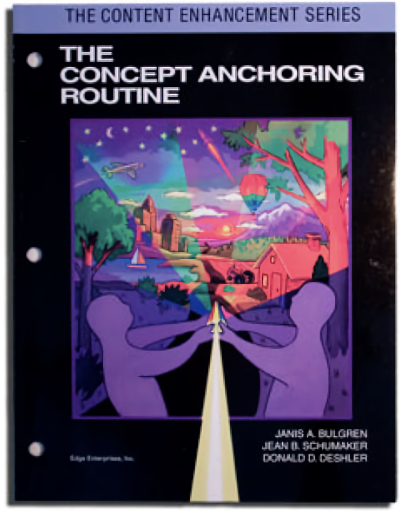The Concept Anchoring Routine

Teachers use the Concept Anchoring Routine to introduce and anchor a new concept to a concept that is already familiar to students, that is, to learn by analogy.
Students whose teachers used the Concept Anchoring Routine had significantly higher overall test scores than students in the comparison condition. In the experimental condition, students with LD scored 25% higher, low-achieving students scored 27% higher, average-achieving students scored 19% higher, and high-achieving students scored 7% higher than these groups in the comparison condition in studies in secondary science and social studies classes.
SIM Graphic Organizer created for this Content Enhancement Routine: Anchoring Table (© 1994)
Author(s):Janis A. Bulgren, Jean B. Schumaker, and Donald D. Deshler
Publication & Purchasing Info: University of Kansas, Center for Research on Learning
KU CRL Online Store
Resources:
Research Articles:
- Deshler, D.D., Schumaker, J.B., Bulgren, J.A., Lenz, B.K., Jantzen, J.E., Adams, G., Carnine, D., Grossen, B., Davis, B., & Marquis, J. (2001). Making learning easier: Connecting new knowledge to things students already know. Teaching Exceptional Children, 33(4), 82-85. This article describes the Concept Anchoring Routine and its use to help adolescents with disabilities grapple with complex concepts.
- Bulgren, J.A., Deshler, D.D., Schumaker, J.B., & Lenz, B.K. (2000). The use and effectiveness of analogical instruction in diverse secondary content classrooms. Journal of Educational Psychology, 92(3), 426-441. This article reports the results of three studies on using analogies to teach important and difficult information. These results indicate that use of the Concept Anchoring Table and the Concept Anchoring Routine can enhance student performance with regard to understanding and remembering secondary subject-matter content.
The Story Behind the Concept Anchoring Routine from author Jan Bulgren:
The development of the Concept Anchoring Routine followed shortly after the development of the Concept Mastery Routine, and it is a logical extension of understandings about how students learn. Although the exploration of characteristics and examples related to a major concept was a common and well-researched approach to helping students acquire an understanding about that critical concept, there appeared to be other paths for achieving this. One of these was teaching by analogy. In fact, the original working name for the Concept Anchoring Routine was the “Analogical Anchoring Routine.” Therefore, the development of this routine was a logical next step in helping teachers as they ensured that students acquired knowledge, understanding, and use of critical concepts.
Indeed, the two routines, Concept Mastery and Concept Anchoring, share common components. The most important of these is that key characteristics of a new concept are identified and highlighted by the teacher and students working together. With the Concept Anchoring Routine, however, students learn about a new concept by building on characteristics shared by the New Concept and an already Known Concept. Usually, the Known Concept is something with which they are familiar in their daily lives. In other words, through the use of this routine, students are building on their background knowledge of a Known Concept to understand a new and challenging concept through the use of an analogy. As such, this routine brings students’ prior knowledge and life experiences to the forefront when they are learning critical concepts.
Moreover, this routine contributes to a series of instructional practices that support a taxonomic hierarchy of learning that is reflected in subject-area learning demands. This routine supports students as they acquire understandings of a single critical concept, and these understandings may be applied to more complex and higher order thinking demands. This hierarchy of supports for thinking begins with facts and concepts, supports the manipulation of information, and finally leads to the use and generalization of important ideas and concepts.
Author's thoughts about Content Enhancement Instruction:
As with the Concept Mastery Routine, the development and research on the Concept Anchoring Routine reinforced my commitment to the key principles that became the foundation for all the Content Enhancement Routines. Among these are that the teacher and students must be partners in learning and that learning must be as interactive and co-constructive as possible, given the large numbers of students in content classes. I also became very aware of the importance of focusing on critical information and concepts that would be used again and again. Furthermore, the wide range of students’ abilities, interests, and needs in general education classes verified the notion that innovative instruction was needed to help all students succeed.
Teacher Feedback on this Product:
Many insights about teaching and learning came from working with the teachers who participated in developing and researching the Concept Anchoring Routing. One insight was that many teachers have preferred ways of thinking. Some teachers found the development of analogies to be easy and intuitive. As a result, they developed many Concept Anchoring Tables quickly and used them enthusiastically. Others found the development of good analogies more difficult.
Another great insight and understanding came from group discussions with the teachers, which were a big part of our development process. That insight was that, as teachers, we all have preferred ways of learning and explaining things. As teachers shared their ease or struggles with developing good concept analogies, they, as a group, came to the understanding that students also had preferred ways of learning. Another light bulb moment! The next group conclusion was that if they, as teachers, learned in different ways, they owed it to their students to teach in different ways. What a great moment to share with teachers!
This manual is available through the KUCRL Shop.
Please note that professional development, coaching, and infrastructure support are essential components to effective implementation of SIM instructional tools and interventions. It is highly recommended that you work with a SIM professional developer. See the SIM Event list for sessions or email simpd@ku.edu to learn more.
An accessible version of the documents on this site will be made available upon request. Please contact the KU CRL Professional Development Research Institute, at simpd@ku.edu to request the document be made available in an accessible format.